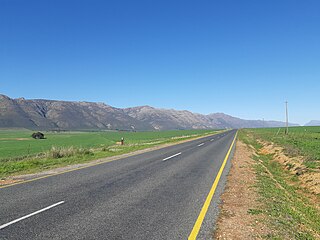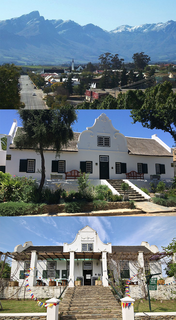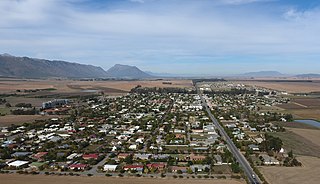
Bergrivier Local Municipality is a local municipality in the Western Cape province of South Africa. It governs the towns of Piketberg, Velddrif and Porterville, as well as the surrounding villages and rural areas. As of 2011 it had a population of 61,897. It is located within the West Coast District Municipality and has municipality code WC013.

The R365 is a Regional Route in South Africa that connects Piketberg and Lamberts Bay.

Tulbagh, named after Dutch Cape Colony Governor Ryk Tulbagh, is a town located in the "Land van Waveren" mountain basin, in the Winelands of the Western Cape, South Africa. The basin is fringed on three sides by mountains, and is drained by the Klein Berg River and its tributaries. The nearest towns are Ons Rust and Gouda beyond the Nuwekloof Pass, Wolseley some 15 kilometres (9.3 mi) to the south inside the basin, and Ceres and Prince Alfred Hamlet beyond Michell's Pass in the Warm Bokkeveld.

The Groot Winterhoek mountains are located in the Western Cape province of South Africa and are part of the Cape Fold Belt comprising a watershed area of 552,606 hectares. They rise to a maximum height of 2077 m just north of the town of Tulbagh as Groot Winterhoek peak. The mountains are predominantly made up of Table Mountain sandstone. Up to 83% of the range is still classified as being in a natural state and up to 72% of the range is protected. The towns of Saron and Porterville are located at the foot the mountain range's western side.
Arthroleptella subvoce is a species of frogs in the family Pyxicephalidae. It is endemic to South Africa and only known from the Groot Winterhoek Wilderness Area, Western Cape. Common name northern moss frog has been coined for it. The specific name subvoce is Latin for "under voice" and refers to the very subdued male advertisement call of this frog.

Porterville is a town in the Western Cape province of South Africa.

The 2015 Cape wildfires were a series of wildfires that burned across the Western Cape from February to April 2015. Major fires burned across the Cape Peninsula starting on 1 March in Muizenberg and burning until 9 March, when firefighters extinguished it. The fire resulted in 1 death, 56 injuries, over 6,900 hectares of burnt land, and 13 damaged properties, of which 3 were destroyed. The cause of the fire was later determined to be arson. There were also major fires near Wellington and Porteville starting in February, which claimed the lives of 3 firefighters and a fire in Stellenbosch that caused the evacuation of the University of Stellenbosch and burned over 2,900 hectares of land.

Protea effusa, sometimes known as the scarlet sugarbush, is a flowering plant which belongs to the genus Protea. The plant is endemic to the Western Cape province of South Africa. In the Afrikaans language the vernacular name blosrooisuikerbos has been recorded for this plant.

Protea rupicola, also known as the krantz sugarbush, is a flowering shrub belonging to the genus Protea. It has a highly branched trunk and grows up to 2m high.
The Klein Berg River is a major right-hand tributary of the Berg River in the Western Cape province of South Africa. The Klein Berg drains the Tulbagh basin through the Nuwekloof into the Swartland, where it joins the Berg.

Leucadendron arcuatum, the red-edge conebush, is a flower-bearing shrub that belongs to the genus Leucadendron and forms part of the fynbos. The plant is native to the Western Cape, South Africa.

Protea scorzonerifolia, the channel-leaf sugarbush, is a flower-bearing shrub belonging to the well-known Protea genus. The plant is endemic to South Africa and occurs in the Du Toit's Kloof, Franschhoek and Groot-Winterhoek mountains. The plant became extinct on the Cape Peninsula.

Leucadendron loeriense, the Loerie conebush, is a flower-bearing shrub that belongs to the genus Leucadendron and forms part of the fynbos. The plant is native to the Western Cape, where it is found in the Elandsberg, Baviaanskloof and Groot-Winterhoek mountains. The shrub grows 2.5 m tall and flowers in December and January.

Serruria aitonii, the marshmallow spiderhead, is a flower-bearing shrub that belongs to the genus Serruria and forms part of the fynbos. The plant is native to the Western Cape and occurs from the Cederberg and Sandveld to the Groot-Winterhoek Mountains and Piketberg. The shrub is round and grows 1.0 m tall and flowers from July to November.
Paranomus lagopus, the rabbit-paw sceptre, is a flower-bearing shrub that belongs to the genus Paranomus and forms part of the fynbos. The plant is native to the Western Cape where it occurs in the Koue Bokkeveld Mountains, Groot-Winterhoek Mountains and Elandskloof Mountain.

Paranomus dispersus, the long-head sceptre, is a flower-bearing shrub that belongs to the genus Paranomus and forms part of the fynbos. The plant is native to the Western Cape, South Africa.
Diastella myrtifolia, the Tulbagh silkypuff, is a flower-bearing shrub that belongs to the genus Diastella and forms part of the fynbos. The plant is native to the Western Cape and is found in the Groot Winterhoek. The shrub is erect to semi-erect with mat-shaped spreading branches.

Sorocephalus lanatus, the common clusterhead, is a flower-bearing shrub that belongs to the genus Sorocephalus and forms part of the fynbos. The plant is native to the Western Cape and occurs in the Cederberg, Groot Winterhoek and Hex River Mountains.
Sorocephalus imbricatus, the tile-leaf clusterhead, is a flower-bearing shrub that belongs to the genus Sorocephalus and forms part of the fynbos. The plant is native to the Western Cape where it is found in the Piketberg, Groot Winterhoek and Elandskloof mountains. However, plants were last observed at the latter two sites 50 years ago.
Spatalla caudata, the woolly-hair spoon, is a flower-bearing shrub that belongs to the genus Spatalla and forms part of the fynbos. The plant is native to the Western Cape where it is found in the Cederberg, Groot Winterhoek Mountains and Hex River Mountains.


















